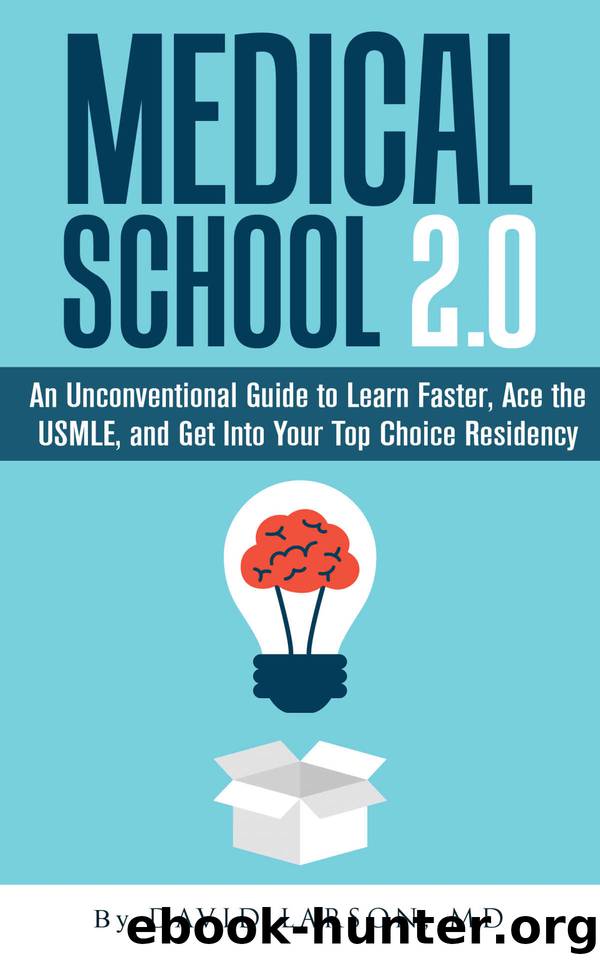Medical School 2.0: An Unconventional Guide to Learn Faster, Ace the USMLE, and Get into Your Top Choice Residency by David Larson

Author:David Larson [Larson, David]
Language: eng
Format: epub
Tags: Medical School 2.0
Publisher: Study Coach MD
Published: 2015-12-17T17:00:00+00:00
If you don’t know the answer, simply look at the back of the card, read the answer, and then actually write the answer on your scratch paper. Then look at the front of the card again and continue this process until you can write the correct answers to the questions you made. As you write, use a lot of space and paper, and use shorthand… This is scratch paper and will be thrown away, so let yourself be fast and messy. I like to use a good ballpoint pen because the ink flows faster and makes it easier to write.
Repeat this process for your first set of 5-8 cards until you can immediately recall each of them. Then move on to the next 5-8 cards.
Step 5: Study the Mini-Deck
After finishing your first set of 5-8 complete cards with questions and answers, study them as a group, ideally in a random (or “shuffled”) order. Again, write down the answers as you look at the questions, and continue repeating the cards for as long as it takes until you can recall them all.
By now, you’ve seen and ACTIVLEY recalled the information on each card several times, and the material is well on its way to being permanently engraved in your long-term memory.
Step 6: Finish the Deck and Do a Comprehensive Review
Repeat steps 4 and 5, in small groups of cards (5-8 at a time), until you’re done with the entire deck you created (most decks are 30-60 cards depending on how big a chapter you’re doing).
After finishing the deck, grab a cup of coffee, or take a quick stretch break, because you’re going to review the whole deck now. Set your flashcard program on shuffle, and this time you’re going to shuffle the entire deck, studying ALL the cards in a random order.
If you can write the answer to a card on the first time, check it off as “known,” and continue to the next card. For all the cards that you didn’t get on the first time, “flag” them for later review (see screencast video for how to flag).
You will now move these “flagged” cards to a separate deck; I call mine “Keepers.” But you could call yours “high yield” or whatever. The point is that this new deck represents a customized chunk of high yield information that is specific for your own learning needs. When it comes time to prepare for a test, instead of giving an equal amount of your time to all the study material as most students do before tests (even studying things they already know), you will be able to focus ONLY on what is uniquely high yield for you, simultaneously saving your hours of review, and increasing your mastery of the subject.
By now, through this focused active learning process, you have practically memorized whatever information you just studied. You have formed a rock solid memory network that you’ll continue to refine and strengthen each time you quiz yourself.
Download
This site does not store any files on its server. We only index and link to content provided by other sites. Please contact the content providers to delete copyright contents if any and email us, we'll remove relevant links or contents immediately.
| ASVAB | GED |
| GRE | NCLEX |
| PRAXIS | SAT |
| See more | Flash Cards |
| Study Guides | Study Skills |
| Workbooks |
Talking to Strangers by Malcolm Gladwell(13292)
The Compound Effect by Darren Hardy(8872)
Tools of Titans by Timothy Ferriss(8305)
Wonder by R. J. Palacio(8058)
The Lover by Duras Marguerite(7857)
A Court of Wings and Ruin by Sarah J. Maas(7730)
The Circle by Dave Eggers(7065)
Deep Work by Cal Newport(6966)
Kaplan MCAT General Chemistry Review by Kaplan(6900)
To All the Boys I've Loved Before by Jenny Han(5806)
Wiseguy by Nicholas Pileggi(5708)
The Body: A Guide for Occupants by Bill Bryson(5030)
Eat That Frog! by Brian Tracy(4483)
1,001 ASVAB Practice Questions For Dummies by Powers Rod(4471)
Cracking the GRE Premium Edition with 6 Practice Tests, 2015 (Graduate School Test Preparation) by Princeton Review(4248)
Pre-Suasion: A Revolutionary Way to Influence and Persuade by Robert Cialdini(4185)
Barron's AP Biology by Goldberg M.S. Deborah T(4122)
ACT Math For Dummies by Zegarelli Mark(4022)
Alive: The Story of the Andes Survivors by Piers Paul Read(3997)
